Some Aspects of the Tonadilla escénica in Its Late Phase
Elisabeth Le Guin
Repaso
The term tonadilla can
refer to several different musical genres, depending on
the period in question. In the second half of the eighteenth
century the term is properly tonadilla escénica,
and it means a kind of comic intermezzo in Spanish: a brief
work for one, two, or sometimes more singers and a small
theater orchestra, sung more or less throughout, and expressly
created to be staged between the acts of longer works like
operas, zarzuelas, or spoken plays. The genre was place-specific—the
great majority of tonadillas escénicas
were written in and for Madrid—and period-specific as well.
The generally accepted date for the first work answering
to this description is 1757, and although tonadillas
were occasionally written well into the nineteenth
century (Francisco Barbieri wrote one in 1881), the genre
had ceased to be a vital tradition by about 1810.
There was a great deal of tension
during the second half of the eighteenth century between
the afrancesados, those Spaniards who followed
the lead of the French in matters of philosophy, the arts,
and fashion, and those who, for a variety of reasons, cleaved
fiercely to old (or sometimes re-invented) Spanish traditions.
This is reflected in the tonadilla texts, which
are topical, directly treating current events, fashions,
and the foibles of audience members, often in terms of their
nationalized affiliations; at the same time, the musical
language cooks up a unique mix of autochthonous Spanish
dance types, French sentimentality, and the lively, limber,
declamatory Neapolitan comic style.
The madrileños
ate it up. Tonadillas enjoyed a tremendous vogue
in Madrid. By the 1780s, the company at each of the two
main theaters was presenting sixty to seventy new works
every season; thus, during the season, a new tonadilla
could be seen in Madrid every few days. The archival
legacy of this time is impressive: the Biblioteca Municipal
de Madrid has almost 2000 tonadillas in manuscript,
as well as 536 sainetes of the great satirical
observer of Spanish customs, Ramón de la Cruz, about
a 100 of which have substantial written musical interludes.
This veritable ocean has been astonishingly little navigated.
Very few tonadillas have been published. La
muerte y resurección de la tirana of Blas de
Laserna, from which comes the "Tirana del Trípili"
used by Granados for "Los requiebros" in his Goyescas,
is very much the exception. Furthermore, the collections
have never been systematically catalogued, although the
MSS are well preserved and lovingly cared for.
Only the great Spanish
musicologist José Subirá can be said to have
really known this repertory; he achieved this by making
the tonadillas central to his life's work, in
the process eschewing academia, teaching, society, and most
visible means of financial support. Since his magnificent
three-volume study of 1932,1
and until the last couple of years, in which scholars at
the Universidad Autónoma de Madrid have produced
an important article and a fine exhibition catalog, which
includes a collection of essays, there has been precious
little scholarly work of any kind on the genre.2
To this day, virtually none of it is in English.
Madrid 's Centro Conde Duque,
which houses the Biblioteca Municipal, has sponsored a series
of tonadilla concerts over the last few years,
in which the madrileños can enjoy the pieces
that their ancestors raved about. In coordination with these
efforts, a good recording has only recently been released;
it is the first adequate performance of any of these works
on disc.3
Justificación
Fine though the concerts are
and the recording is, I cannot imagine that the tonadilla
escénica will ever recuperate the popularity
it once had with its listening public. It was too much a
phenomenon of its time; we have lost too much of the original
context. Thus, the genre embodies one of the fundamental
paradoxes of the discipline of musicology: what use can
there be in poring over the fossilized remains of an art
form whose immediacy was its soul and reason for being?
This question hovers poignantly
over my recent work in the genre. If pressed for an answer,
I would have to say that the use of such study is in looking
more closely at, and thus honoring, the past; and that doing
this is important because we tend to find that in honoring
the past, we better come to understand ourselves in the
present. Tonadillas escénicas provide windows,
some of astonishing clarity and others of fascinating distortion,
onto a place and a time that have disappeared forever—and
which yet persist, in a thousand likenesses large and small.
To name only a few of the largest: Spain in the period 1785-1805
and Spain in 2005 are both contending with the impact of
a big wave of immigration; both are still emerging from
long periods of cultural isolation (the one from the long
Hapsburg dynasty, the other from the dictadura
of Franco) into relative modernity; both are prosperous
for the first time in living memory. Questions that arise
in relation to the one period tend to apply to the other,
a fascinating and perilous exercise in historical relativism.
Thus, an immediacy—a mediated immediacy, I suppose we would
have to call it—does in the end emerge.
Or, to answer the question
in another way (but perhaps, in the end, a more appropriate
one): there is the fact that the madrileños
still chuckle at the humor in these works.
Ejemplo
I propose to concentrate here
on a single tonadilla. I will not attempt to be
particularly synoptic nor systematic about my treatment.
Those who are interested in the general textual, structural
and stylistic features of the genre cannot do better than
to go to Subirá, who describes them with mastery;
and those who would like to get to know the piece more thoroughly
can find this particular tonadilla in a good recent
edition. Rather, I hope here to give a brief glimpse of
how these works once operated, and of what can still be
interesting and attractive in them.
The work is entitled La
lección de música y de volero, and its
music was composed by Blas de Laserna (1751-1816). In all
likelihood, so was its poetry. Laserna, a remarkable jack-of-all-trades
and one of the most prolific composers in the whole eighteenth
century, wrote the libretos for a number of his
more than 800 (!) tonadillas . The first performance
came in the spring of 1803. From the worn and much-marked
condition of the parts, it appears to have been a particularly
popular work, probably re-staged a number of times during
ensuing years.
|
Mutacion
de sala di ensayo con puerta en el foro q.e figure
la entrada de la calle sillas &a.
The work opens with "Berteli" and
"Eusebio," tenor and bajo respectively. Berteli
plays the part of the "autor," or company director.
The two are trying to figure out how
they will mount the coming summer season of tonadillas,
without any women singers to speak of.
After this opening number, we get
a spoken exchange in which Eusebio offers to sing
the women's parts, and Berteli agrees to let him
do it.
Then some women do appear: la Virg
(=María Josefa Virg), and "la Bolera," a
bailarina .
There is some banter between the
men and these women. They still do not know what
tonadilla to put on, because they still lack a dama
de parte de cantado . . . .
. . . so they decide to pass the
time as fruitfully as they can until she shows up:
to wit, Eusebio engages to practice solfa
with La Virg.
Meanwhile, Berteli tells the bailarina
, "While they have their lesson, I'll review
the bien parado you taught me yesterday." |
|
A
rehearsal hall with a door in the back through which
can be seen the entry to the street; seats etc.
Allegro, A Minor, 2/4 time
The singers' real names were Sebastiano
Berteli and Eusebio Fernández. It was common
practice for tonadilleros / as
to act and sing under their own names. De la Cruz
used the same, curiously "transparent" convention
in his sainetes .
This, like most of the meta-theatrical references
with which tonadillas abound, is documentary.
Due to repeated administrative conflicts and failures
from 1799-1802, the Madrid theatrical companies
were still in a woeful state. 4
There is a fair amount of this
sort of gender silliness in the tonadillas ,
up to and including having a bajo sing an entire
sentimental aria in falsetto, or a soprano an entire
aria in the buffo tenor range (an example occurs
in Laserna's Cómica y la operista
of 1783).
The bolero was at the height of its popularity
at this time, and boleros, along with fandangos
, contradanzas , padedús
, and minués , were often programmed
as independent events alongside operas and tragedies.
From the 1790s, theatrical companies had begun keeping
dancers on staff for this.
The tonadilla had always
been a genre heavily reliant on the singing and
dancing of women. 5By
this late date in the history of the genre, the
level and nature of that singing and dancing had
evolved to require professional operatic and dance
techniques. Gone were the days of the untrained
comic singer-actress-dancer.
Andantino, A Major, 3/4, movimiento
de seguidillas (=bolero).
María Josefa Virg did not
specialize in singing parts (she was to achieve
her greatest fame in 1806 as Paquita in Moratín's
enormously popular El sí de las niñas
).
This refers to the practice whereby
at the end of a bolero —or even at the
end of sections or phrases—the dancers froze, holding
elegant and artful poses, competing for cries of
"Bien parado!" from the onlookers. 6
There is a sardonic twist here,
made clear in later spoken passages. Berteli (as
his name suggests) was of Italian birth, and the
very idea of an Italian trying to dance the bolero
was evidently funny to the audience. |

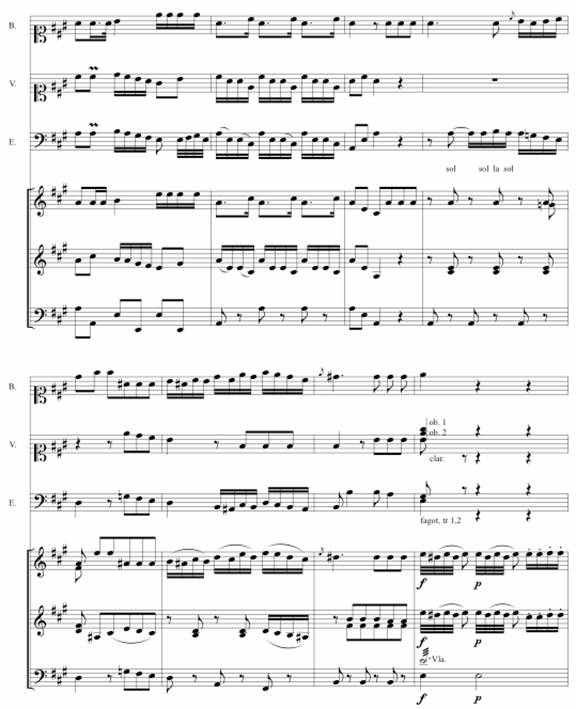
The orchestra is the minimum
for tonadillas: two violins (doubled in this production,
as there are two surviving parts for each) and contrabajo,
usually doubled by guitar and/or keyboard.
This is a different solfa
system than the one most of us know. Possibly it is
deliberately wrong, a parody; but it is perfectly consistent
with itself, to an extent that suggests instead that it
is a distinct, apparently tetrachordal system.
One can see that Eusebio must
have been a pretty agile bajo. In the theater records
he is described with the Italian term buffo (as
well as gracioso, the old term for a comic character).
A good measure of his vocal and dramatic skill can be found
in the fact that in May and June of 1802, about a year before
this tonadilla premiered, he sang the title role
when Mozart's El casamiento de Fígaro
(in Castilian translation) was first staged in Madrid at
the Teatro de los Caños del Peral.
At bar 5,
Berteli begins his own melody (and, we presume, his attempts
at imitating La Bolera's dance) with a series of vocables.
It is interesting to take note of the differences between
the "neutral" (=Italian comic) style of the music sung by
Eusebio and la Virg, and what Berteli sings (the dotted
rhythms, the relatively measured delivery, the tied-over
phrase-ending characteristic of seguidillas and
boleros). After sixteen bars of this artful group
chaos, however, the musical landscape changes rather abruptly,
with the entrance of a much larger orchestra—viola, clarinet,
oboes, bassoon, and horns. The meter, the tempo, and the
tonality, however, do not change, although we lose the bolero
"feel," by virtue of losing the characteristic dotted rhythms
and the tendency toward a harmonic rhythm that moves on
beats one and two of a three-beat bar.
|
The
grand introduction is for the arrival of La Martina,
the long-awaited parte de cantado , and
the artist for whom this tonadilla served
as a formal introduction to the Madrid audience.
She enters singing a virtuoso aria
with a typically silly allegorical text, in perfect
disregard for the others, who (understandably) fall
silent.
We might imagine them striking
poses of surprise and interest at this unexpected
entry. |
|
This
tonadilla marks the first time Martina
Iriarte sang at the Teatro de la Cruz, where this
tonadilla was produced. 7
Although we do not have much detailed information
about La Martina, from the vocal writing it is clear
that she must have been well trained in the Italian,
bel canto style.
Stage directions of this or any
other type are almost entirely lacking in tonadillas
; we must usually infer them.
|
It is interesting to note that as soon as
La Martina sings, Laserna once again cuts back the orchestra
to its minimum. Whereas the augmented forces that introduced
her amounted to a kind of sonic topos—signifying
"opera," as opposed to "intermezzo"—the reduction here may
have been in order to show her vocal prowess to best advantage.
It was the custom in tonadillas for the violins
to double the voice lines, and quite rare for the texture
to operate otherwise. The fact that La Martina could sing
something this showy without that support is itself an advertisement
for her talents.
Martina seems unaware of the others at first,
absorbed in practicing her aria. We know she sees them,
however, when the meter and tempo change:
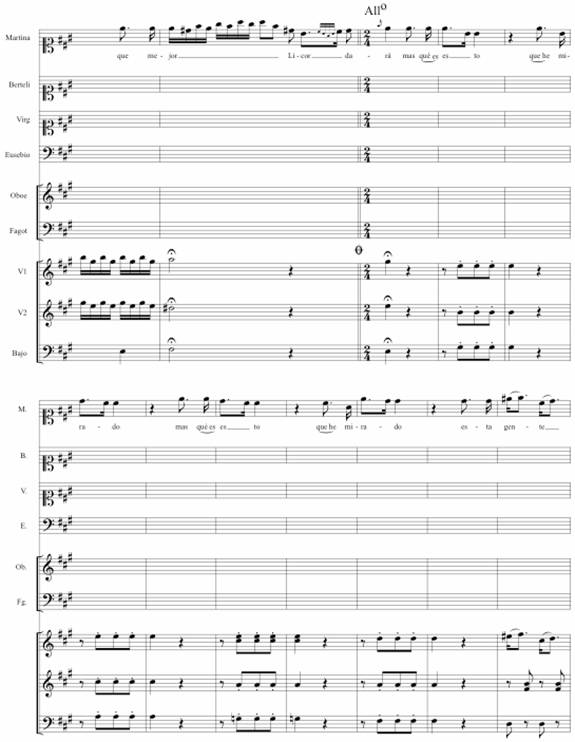
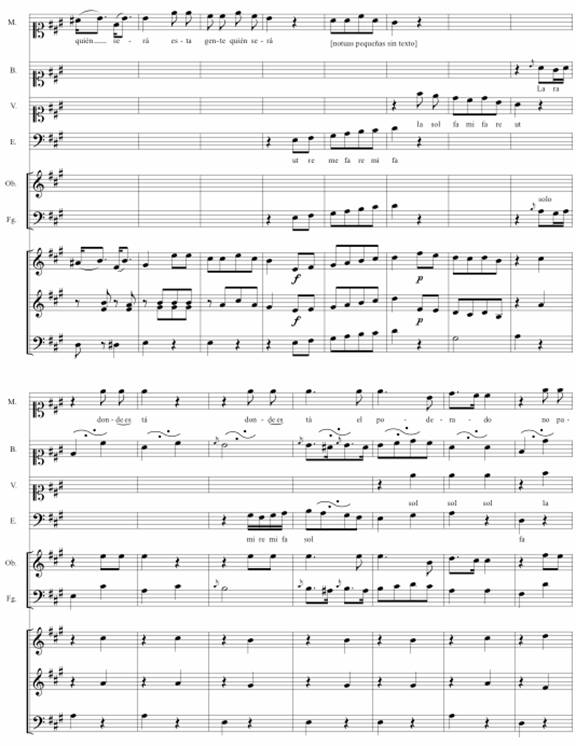
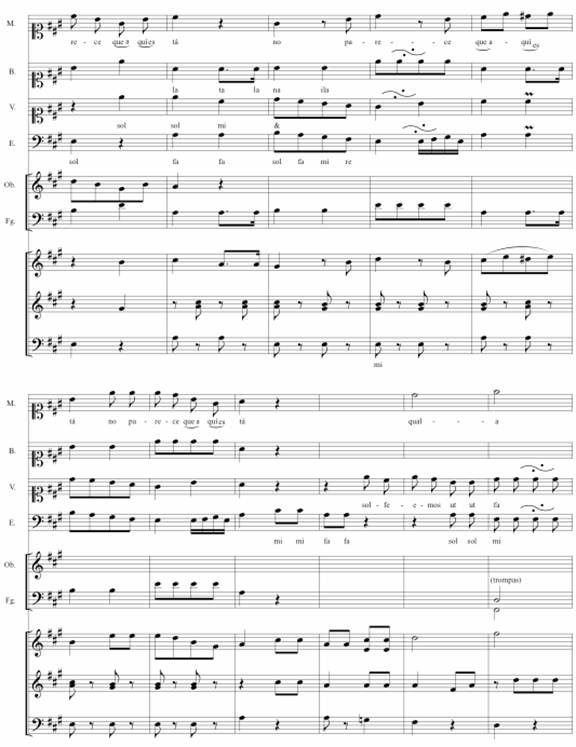
Now
everyone is, as it were, "on the same page" for
the first time. Each accordingly begins to "do their
thing," simultaneously: the standard signal for
an Italian comic finale, and indeed the music is
a die-cut Italianate Allegro.
• Martina complains,
diva-style, that the director of the company does
not appear.
• The solfa
lesson resumes.
• The bolero
lesson continues.
At bar 36 of the example ,
Martina begins to practice her aria again.
Berteli begins to sing along with her, introducing
her to the audience in buffo style, as
she shows off her cantabile .
|
|
The apparent metrical contradiction here—a bolero
in an Allegro 2/4 time—is made possible by
a clever rhythmic sleight-of-hand on Laserna's part.
When Berteli enters in bar 19 of the example (doubled
this time by the bassoon), he sings his original bolero melody (ex. 1, bar 5 ),
its three beats now extended across three
bars of the ongoing 2/4 time. Thus through
a simple adaptation of harmonic rhythm, we get to
hear the dance that had come to represent quintessential
Spanishness, even to Spaniards themselves, without
ruffling the bustling Italianate surface. The moment
is a brilliant example of musical hibridación
.
At this point, the harmonic rhythm
reestablishes itself seamlessly in two-bar phrases;
the bolero lesson is over. From here to
the end of the number, there is that escalation
of energy and activity that we (just like audiences
of the day) know so well from Italian comic opera
finales, culminating in repeated, emphatic cadences.
|
There is quite a bit more
in this piece, which is on the long and elaborate side for
a tonadilla. The general gist is the introduction
of La Martina, who emerges as very diffident about her evident
skills, and very anxious to please: this was the ritual,
placating posture of the nueva before the notoriously
fickle and judgmental Madrid audiences, a posture documented
in literally hundreds of tonadillas.
I will focus on just one other
place in this piece, where again, dance music plays an interesting
role. This occurs when, having at last a dama de cantado,
the company members set about choosing their tonadilla.
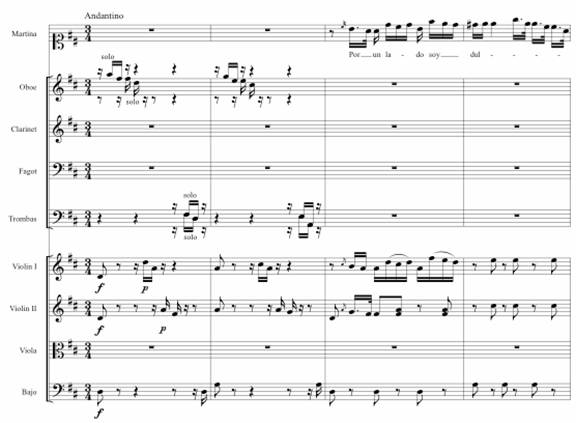
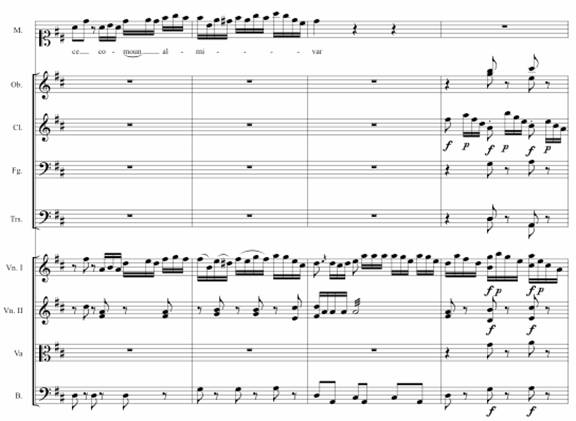


Berteli
asks Martina, "What kind of character do you like
[to play], serious or maja?"
She replies with a song:
On the one hand I'm sweet
as sugar syrup
On the other I'm salty
like myself.
I'm a compound,
of pleasant sour-sweetness,
of majo and serious. 8
|
|
"Serious"
seems here to have meant "operatic" (itself an interesting
equation); the music La Martina offers in proof
of her "seriousness" would more likely be called
"sentimental" nowadays.
"Maja," meanwhile, is arguably
the most loaded term of the entire late eighteenth
century in Spain. Through it we may infer a host
of qualities that existed along a continuum of resistance
to everything that opera represented: autochthonous
culture, membership in the lower social classes,
grace and humor ( sal ), fierce nationalist
pride, an emphatically embodied personal genuineness.
. . .
This begins as a sort of bel-canto-ized
seguidillas : sweet indeed. 9
However, in bar 10, the last time Martina sings
"almivar" (sugar syrup), the accompaniment "goes
salty" on her (a shift to the relative minor via
a "wrong note," A#, and the V/vi is heralds, and
an up-tempo shift); our sentimental opera heroine
is suddenly another girl, purely through change
of seguidilla -type (although this time
she retains her opera-orchestra accompaniment).
Iriarte, despite her Italian training
and vocal presentation, seems to have been Spanish-born:
a distinction that mattered to the audience. Here,
with Laserna's expert assistance, she abruptly presented
them with her maja credentials.
The subtlety and artfulness of
Laserna's use of topical associations within a single
dance-type to create character is comparable to
the subtlety and artfulness of Rameau or Mozart.
|
Conclusión
It is worth noting, in conclusion,
that having demonstrated her maja nature, La Martina
does not thereafter "revert" to it. She could not have done
so. In 1803, such a simplistic solution to the question
of musical Spanishness (a question symbolized in this little
work by its own metatheatrical consternation over how to
choose which tonadilla to sing) could no longer
"fly." In fact, the piece-within-a-piece is never chosen;
or rather, it is the piece itself, which casually ceases
to frame its story-within-a-story and becomes its own subject
matter.
In the tonadilla's
middle section, or coplas , in a curious, hybrid
dance rhythm that might or might not be Iberian, the three
principal parts complain that things are not as they once
were in the realm of the tonadilla . In the second
verse, they sing as follows:
Martina
Ay, endless apasionados
for the Spanish style.
Berteli.
Well, then sing the tonadillas
of Morales and Misón.
Eusebio
Thus we'll have the grace
which the Nation has lost. |
|
Morales and
Misón we and still are generally celebrated
as the first composers in this genre; their works
date from the 1750s and 1760s respectively |
But of course, that grace
had already been lost forever—if indeed it had ever existed
in the ideal form yearned for here. If not everybody present
in the Teatro de la Cruz knew this yet, they would know
it soon enough, after the disastrous French invasion of
1808. In any case, Laserna clearly knew it already. Martina
sings:
I
don't know then, I don't know.
Ay, God what a thing.
What a thing, I don't know
in that case what we'll sing.
Ay, but joy anew
returns to give vigor to the soul,
the sweetness of calm
will always reign there. |
|
Allegro
Moderato, in common time and with majestic dotted
rhythms, after an abrupt but not wrenching move
to the key of Eb Major
With the second verse, Berteli
and Eusebio join in. Somehow, without benefit of
narrative transition, all the preceding doubt seems
to have evaporated. |
How is this "solution"
effected or justified? The answer is not evident in the
text at all, but it emerges quickly enough in the score:
to these serene words, La Martina begins an elaborate coloratura
in triplets, an exuberant display of thoroughly Italianate
virtuosity. The answer to the artists' collective dilemma
is thus announced clearly enough through musical style.
From this point to the end of the piece (and indeed from
this historical point to the effective end of the tonadilla
tradition), opera—"serious" music—had clearly won
the day.
1
José Subirá, La tonadilla escénica.
3 vols. (Madrid: Tipografía de Archivos Olózaga,
1928-30). Subirá himself published a useful shorter
"digest" version of his magnum opus: La tonadilla
escénica: sus obras y sus autores (Barcelona:
Editorial Labor, S.A., 1933).
2
See, for example, VV.AA., La Tonadilla Escénica:
Paisajes sonoros en el Madrid del S. XVIII (Madrid:
Museo de San Isidro, 2003) (exhibition catalog with chapters
by Begoña Lolo, Germán Labrador, Acensión
Aguerrí, Emilio Moreno, and others); and Lolo, Begoña,
"La tonadilla escénica, ese maldito género,"
Revista de musicología 15 (2002).
3
El maestro de baile y otras tonadillas (works
of Misón, Rosales, Esteve, Laserna and Moral), Ensemble
Elyma, dir. Gabriel Garrido, Harmonia Mundi, K617151, 2003.
4
See, for instance, Chapters 5-8 of Emilio Cotarelo y Morí,
Isidoro Maiquez y el teatro de su tiempo, Estudios
sobre la historia del arte escénico en España,
III (Madrid: Imprenta de José Perales y Martínez,
1902). Cotarelo's remarks are on p. 196.
5
"[L]as cantarinas embelesaban a los espectadores por las
gracias de los chascos o de los dichos propios de la plebe,
remedados con viveza y energía." ("The women singers
captivated the spectators with the grace of the tricks and
sayings of the common people, imitated with liveliness and
energy.") Memorial Literario de Madrid , September
1787. The entire text of this important early description
of the genre is given in Subirá, i, 285-87.
6
"[N]o todos tienen aquellos bienparados graciosos, en donde,
quedándose inmoviles, el cuerpo descubre con tranquilidad
y descanso hasta las más pequeñas gesticulaciones
del rostro. La serenidad en los pasos y mudanzas dificiles
es la primera cosa que se debe observar en este baile. .
. ." ("Not everyone has [can do] those attractive bien-parados,
in which, staying immobile, the body shows with calm and
repose even the smallest motions of the face. The serenity
in the steps and difficult moves is the first thing which
must be observed in this dance. . . .") Antonio Cairon,
Compendio de las principales regals del baile,
(Madrid 1820). Quoted in Javier Suárez Pajares, "Bolero,"
Diccionario de la música española e hispanoamericana
, ed. Emilio Casares Rodicio, with J. López-Calo
and I. Fernández de la Cuesta (Madrid: Sociedad General
de Autores y Editores, 1999- ).
7
Cotarelo asserts that the de la Cruz company was much the
weaker of the two at this time, being dedicated largely
to spoken drama. See Cotarelo, Isidoro Maiquez, 196.
8
Por un lado soy dulce / como un almibar; por otro soy salada
/ como yo misma; formo un compuesto / de un agridulce grato
/ de Majo y serio.
9
Here we should perhaps recall the truly chameleonic variety
of this dance type. Subirá suggests numerous sub-types
of seguidillas, in addition to the seguidillas
de bolero, which we have already encountered: seguidillas
aminuetadas, gitanas, de maja, de
gallego, etc. |









